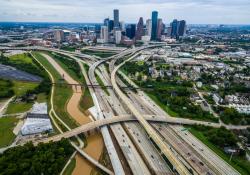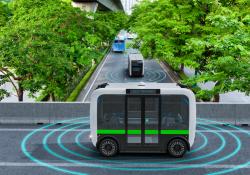Work being carried out by the University of Toronto’s Intelligent Transportation Systems Centre could have a beneficial effect on the city’s congestion problems.
Says Professor Baher Abdulhai of the Centre, "Everybody realises that we have a big congestion problem in Toronto and the scarier part is that it's getting worse, exponentially."
One of the solutions he's working on is smarter traffic lights using artificial intelligence to control the flow of traffic. "Each traffic light would learn how to time itself, like green and yellow and so on and switch from a phase to another based on the actual traffic it sees and senses along the approaches to that intersection."
The new part, he says, is the lights would communicate wirelessly with nearby intersections to make sure they're working together to move traffic along. "They would negotiate with each other to come up with an optimal plan for the local conditions at a given traffic light but also taking in to consideration the neighbouring traffic lights," he says.
The results, he says, are very significant. In computer simulations, they tested an area of downtown bounded by Bathurst Street, Front Street, the Don Valley parkway and Lake Ontario. Using their software, he says they found the average delay was reduced 40 per cent. In some key intersections, he says delays were down 60 to 70 per cent.
"It's better for the environment, better for overall travel time but significantly better at intersections themselves."
About 15 per cent of the city's 2200 traffic lights are currently controlled by a SCOOT system, which uses sensors embedded in the roads to monitor and adjust the timing of the lights based on traffic patterns. It's connected to the city's central traffic command centre. The technology is about 20 years old and is showing its age. The city is currently undergoing a year-long review of the system but says the new technology still needs to be proven.
The proving ground for the technology could be a business park in Burlington. Transportation planners there are looking at the technology to solve congestion at a major intersection, where rush hour congestion from the surrounding offices had officials considering an US$8-million re-build of the intersection.
Abdulhai and his team demonstrated that their system could achieve improvements in traffic flow similar to the construction, but without the mess, and for a cost of about US$200,000.
Burlington's Director of Transportation Services Bruce Zvaniga calls the results of the simulations there ‘promising’, but says it is no silver bullet that would eliminate congestion altogether. He also notes there is a long time between the research phase and an on-street trial.
Over the next six months, Abdulhai is working with Burlington, testing the technology in the lab using real-world hardware. He hopes the results will lead to field tests and encourage other municipalities to look at the technology.
Says Professor Baher Abdulhai of the Centre, "Everybody realises that we have a big congestion problem in Toronto and the scarier part is that it's getting worse, exponentially."
One of the solutions he's working on is smarter traffic lights using artificial intelligence to control the flow of traffic. "Each traffic light would learn how to time itself, like green and yellow and so on and switch from a phase to another based on the actual traffic it sees and senses along the approaches to that intersection."
The new part, he says, is the lights would communicate wirelessly with nearby intersections to make sure they're working together to move traffic along. "They would negotiate with each other to come up with an optimal plan for the local conditions at a given traffic light but also taking in to consideration the neighbouring traffic lights," he says.
The results, he says, are very significant. In computer simulations, they tested an area of downtown bounded by Bathurst Street, Front Street, the Don Valley parkway and Lake Ontario. Using their software, he says they found the average delay was reduced 40 per cent. In some key intersections, he says delays were down 60 to 70 per cent.
"It's better for the environment, better for overall travel time but significantly better at intersections themselves."
About 15 per cent of the city's 2200 traffic lights are currently controlled by a SCOOT system, which uses sensors embedded in the roads to monitor and adjust the timing of the lights based on traffic patterns. It's connected to the city's central traffic command centre. The technology is about 20 years old and is showing its age. The city is currently undergoing a year-long review of the system but says the new technology still needs to be proven.
The proving ground for the technology could be a business park in Burlington. Transportation planners there are looking at the technology to solve congestion at a major intersection, where rush hour congestion from the surrounding offices had officials considering an US$8-million re-build of the intersection.
Abdulhai and his team demonstrated that their system could achieve improvements in traffic flow similar to the construction, but without the mess, and for a cost of about US$200,000.
Burlington's Director of Transportation Services Bruce Zvaniga calls the results of the simulations there ‘promising’, but says it is no silver bullet that would eliminate congestion altogether. He also notes there is a long time between the research phase and an on-street trial.
Over the next six months, Abdulhai is working with Burlington, testing the technology in the lab using real-world hardware. He hopes the results will lead to field tests and encourage other municipalities to look at the technology.











